Joe Frank FB
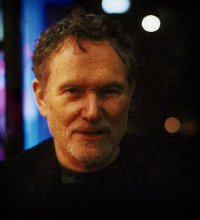 Joe Frank has been writing regularly on Facebook. So for those FB-ers among us, check out his oft-updated page.
Joe Frank has been writing regularly on Facebook. So for those FB-ers among us, check out his oft-updated page.
 Joe Frank has been writing regularly on Facebook. So for those FB-ers among us, check out his oft-updated page.
Joe Frank has been writing regularly on Facebook. So for those FB-ers among us, check out his oft-updated page.
“From the opening moments, “Cowboy” seizes the heart and soul of the listener for an extraordinary hour. Josh Darsa’s strong story vision and great writing, combined with John Widoff’s brilliantly clear and intimately warm recordings and mix, produced a radio experience that remains unequaled to this day. Listen to “Cowboy” and think about what went into it: planning, attention to detail, patience, and the faith and confidence that the highest standards are both achievable and worth all the work they require. A masterpiece that has endured for decades already, and surely will for many more.”
–Alex Chadwick, June 1998“This was the height of my career at NPR. It was a combination of everything… the music recording, the production sound recording, interviews… every single thing that I had ever done for this company all came together in this show. This was probably how Walt Disney felt when he made Mary Poppins. It was a dream come true for me to build something like this. ‘Cowboy’ is the kind of show you would listen to in a darkened movie theatre. The writing is spectacular.”
–John Widoff, May 1998
NPR.org: ‘Cowboy,’ a Study in Radio Tale-Telling
Hearing Voices episode: “Cowboy”

[The following liner notes are from the 1998 CD of “Cowboy,” Volume 1 in the NPR Engineering Master Series:]
In 1980, journalist-producer Josh Darsa, technical director and recording engineer John Widoff, assisted by Miles Smith, Dave Glasser and shop technician Bob Butcher, collaborated on Cowboy, a project that has become a classic of radio journalism. Cowboy was originally broadcast on October 4, 1980 on a series called The Mind’s Eye. In an interview with Mike Starling, Vice President of NPR Engineering, John Widoff describes their unique effort.
Mega Decks, Mega Mics, Mega Mix
JW: While we were at the rodeo, Josh Darsa wanted to record multiple vantage points of a single scene. For instance, I’d have a Nagra tape recorder on the roof of the grandstand and Miles Smith, a freelancer out of New York (currently Boston), would have a Nagra in the chutes where the riders would bust out for their ride. Then we would have a freeorunning Nagra III on the rodeo announcer. We ran them in sync kinda like you would do in video with multiple cameras. This gave us three different vantage points. During the show you hear the perspective change through cross fading which is a result of these different but simultaneous perspectives. More…

![]() Hearing Voices from NPR®
Hearing Voices from NPR®
064 Outer Space: Moon and Beyond
Host: Barrett Golding of Hearing Voices
Airs week of: 2009-07-15 (Originally: -0-0)
“Outer Space” (52:00 mp3):
For the anniversary of the first Man on the Moon, July 20th 1969:
“Exploration” (3:25) is put to music by The Karminsky Experience from The Power Of Suggestion (2003).
In the early 1960’s, the United States was losing the Space Race. The first satellite in was the USSR’s Sputnik, 1957. The first human in space was Soviet cosmonaut Yuri Gagarin, April 1961. The next month President JFK made a Special Address to the US Congress (2:10), that started the program which landed us on the moon eight years later.
“President John Kennedy’s Special Message to the Congress on Urgent National Needs, May 25, 1961”
“Zero G, and I Feel Fine” (6:01) transmissions are from the Mercury, Gemini and Apollo missions, with music by Jeff Artnsen of Racket Ship.
A women dreams of a visitor from the “Third Planet” (2:14) by Bisophere.
The “Last Man on the Moon” (2:41) are Apollo 17 astronauts Ronald Evans, Eugene Cernan, and Harrison Schmitt. They left the lunar surface December 1972. No one’s been back since. The music was by Jeff Arntsen.
A President has a distorted phone conversation with an underwater spaceman in “LBJ & the Helium Filled Astronaut” (7:21). Commander Scott Carpenter spent thirty days in the ocean at a depth of 200 feet as part of the Navy’s SeaLab project. This 1964 tape of helium speech comes to us from Larry Massett and Lost and Found Sound. More…
Arbitron’s 2008 National Radio Listening Report estimates 235+M U.S. listeners per week tune into their radios (up from 234M in 2007):
Radio reaches 92 percent of persons 12+ each week, despite the adoption of MP3 players and the growth of Internet-only stations. Even 89 percent of the youngest radio audience, teens ages 12-17, most accustomed to using new technologies and forms of media, continue to tune in each week. Network radio also reaches nearly 85 percent of the ad elusive and media multi-taskers Adults 18-34.
Radio reaches more than 94 percent of college graduates ages 25-54. Ninety-five percent of adults 25-54 with a college degree and an annual income of $50,000 or more tune into radio over the course of a week.
Network affiliated stations reach nearly 86 percent of college graduates ages 18-49 with a household income of $75,000 or more. All radio stations reach close to 94 percent of this age group.

![]() Hearing Voices from NPR®
Hearing Voices from NPR®
063 Lincoln Monument: A Civil War
Host: Barrett Golding of Hearing Voices
Airs week of: 2011-06-29 (Originally: 2009-07-01)
“Lincoln Monument” (52:00 mp3):
For Lincoln’s birthday bicentennial year and Independence Day, Old Abe, the Civil War, and its still-present aftermath:
The United States Marine Band recorded a “Lincoln Centennial” on February 12 1909 (from A Lincoln Portrait).
Abe’s 1860 presidential campaign song was “Lincoln and Liberty;” it’s sung for us by Dan Zanes (ex-Del Fuegos, off Parades And Panoramas: 25 Songs Collected By Carl Sandburg For The American Songbag).
“I Heard Lincoln That Day,” says Gettysburg eyewitness Walter Rathvon, in archival audio recorded on Lincoln’s birthday 1938 by WRUL radio, Boston. Set to an instrumental “Lincoln’s Triumph (a Funeral March),” part of the Lincoln Shuffle (by Bryce Dessner, guitarist for The National and Clogs, composed for the great bicentennial site 21st Century Abe, used with their re-mixing blessings).
NPR recreates the “Gettysburg Address,” with the words of John Dos Passos read by Noah Adams, and Lincoln’s speech read by Lars Hoel; produced by Bob Malesky for NPR’s The Sunday Show. More…
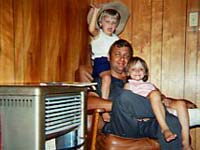
![]() Hearing Voices from NPR®
Hearing Voices from NPR®
062 Talking Dads: For Father’s Day
Host: Larry Massett of Hearing Voices
Airs week of: 2011-06-15 (Originally: 2009-06-17)
“Talking Dads” (52:00 mp3):
Sons daughters, and dads (photo: Pat Vowell with his twins, Amy and Sarah):
Storyteller Kevin Kling shares pancakes with his “Dad,” from his CD Home And Away.
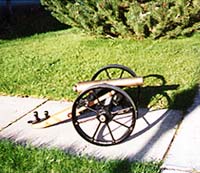 Sarah Vowell is a gunsmith’s daughter, in “Shooting Dad,” produced for This American Life (from Lies Sissies & Fiascoes
Sarah Vowell is a gunsmith’s daughter, in “Shooting Dad,” produced for This American Life (from Lies Sissies & Fiascoes). Sarah’s latest book is The Wordy Shipmates
. (Music: “Rebel Rouser” Duane Eddy 1958 Have Twangy Guitar Will Travel, “Burnt Down With Feedback” Phono-Comb 1996 Fresh Gasoline, “Your Good Girl’s Gonna Go Bad” Jonathan Richman 1990 Jonathan Goes Country.)
Joe Frank lets us eavesdrop on a father-son phone call between “Larry and Zachary” Block, from Joe’s hour Karma 3.
Host Larry Massett and several other sons try to get to know their “Lost and Found Fathers,” produced for Soundprint, with help from Barrett Golding, Brian Brophy, Bob Burrus, and Henry Dennis.
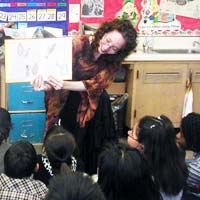
![]() Hearing Voices from NPR®
Hearing Voices from NPR®
061 Educating Esme: A Teacher’s Diary
Host: Alex Chadwick of Interviews 50 Cents
Airs week of: 2009-6-10
“Educating Esme” (52:00 mp3):
During her first year teaching fifth grade in a Chicago public school, Esmé Codell kept a journal. This radio hour is based on her book Educating Esmé: Diary of a Teacher’s First Year. Produced by Jay Allison with Christina Egloff for their Life Stories series and Chicago Public Radio. (This version is slightly edited for time; the original is at PRX.)
Esmé Raji Codell: Planet Esme | Blog | Amazon | Audible | WBEZ 848 | LOC Webcast.
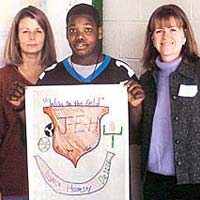
Photo by Katie Davis:
Jesse Jean with Teri and Toni.
![]() Hearing Voices from NPR®
Hearing Voices from NPR®
060 Getting Out: The Education of Jesse Jean
Host: Katie Davis of Neighborhood Stories
Airs week of: 2010-05-05 (Originally: 2009-06-03)
Getting Out: The Education of Jesse Jean (52:00 mp3):
Go to school, keep your grades up, go to college. That’s what we tell kids — over and over. What if just leaving your apartment, and walking up the block is risky? What if it feels safer to stay home, play video games, keep a low profile. When you do go out, head somewhere safe, like the teen center, the basketball court. That was the world of African American teenager, Jesse Jean.
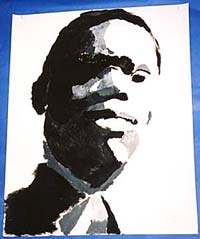
Jesse lived a half a block from host Katie Davis in their Washington DC neighborhood. He was lucky enough to get a scholarship to a private boarding school and brave enough to take it. Katie kept in touch with Jesse, as he moved into this new world. We hear three stories covering seven years, starting in summer, 2001.
Jesse’s Stories on NPR: 2002 Turning the Corner (photos) | 2004 Beyond Myself (photos) | 2008 An Urban Teen Beats The Odds.
The finalists have been announced in the Radio-Mercury Awards for radio spots. A couple of my faves:
Client: The Canyons Resort
Agency: Crowell Advertising
Spot Title: “Do It” (1:00 mp3):
Client: State Fair Of Virginia
Agency: Siddall
Spot Title: “Yesterday” (1:00 mp3):
 On WFMU’s Beware of the Blog is an ATC Theme Overload. More than a dozen mp3s of the All Things Considered “dinks,” along w/ a link to listener suggested lyrics.
On WFMU’s Beware of the Blog is an ATC Theme Overload. More than a dozen mp3s of the All Things Considered “dinks,” along w/ a link to listener suggested lyrics.
There’s the seminal sappy synth:
“ATC Theme- 1971 original” (1:52 mp3):
The breathy brass of the:
“ATC Theme- Washington Saxophone Quartet” (0:29 mp3):
To which we’ll add our own:
“ATC Theme- Dinky the Dingo” by Larry Massett (2:12 mp3):
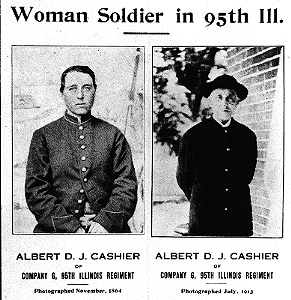 Jennie Hodgers or Albert Cashier? The story of a Civil War veteran is the new Transom Show: Jennie’s Secret. This her-history of a women in a man’s world, produced by Linda Paul with Jay Allison, spans half the 19th Century.
Jennie Hodgers or Albert Cashier? The story of a Civil War veteran is the new Transom Show: Jennie’s Secret. This her-history of a women in a man’s world, produced by Linda Paul with Jay Allison, spans half the 19th Century.
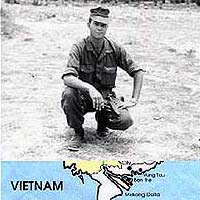
![]() Hearing Voices from NPR®
Hearing Voices from NPR®
059 War Memorial: Return to Vietnam
Host: Alex Chadwick of Interviews 50 Cents
Airs week of: 2011-05-25 (Originally: 2009-05-20)
“War Memorial” (52:00 mp3):
For Memorial Day, two stories recorded in Vietnam, one after the war, and one during:
In 1966, a young Lance Corporal carried a reel-to reel tape recorder with him into Vietnam. He made tapes of his friends, of life in fighting holes, of combat; and he continued to record until, two months later, when he was killed in action. Friend and fellow marine, Tim Duffie, remembers him in “The Vietnam Tapes of Michael A. Baronowski,” produced by Jay Allison and Christina Egloff for Lost & Found Sound. NPR: story | response | credits/links; American RadioWorks: transcript; Lance Cpl Baronowski: Memorial.
Host Alex Chadwick first went to Southeast Asia was as a soldier in the Sixties. Two decades later, he made a “Return to Vietnam” as a journalist, on the anniversary of the Tet offensive, to find what had and hadn’t changed since the war (producer: Art Silverman, engineer: Flawn Williams).
![]()
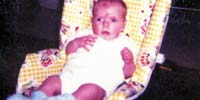 When Carol Brobeck was 20, she gave her baby boy away for adoption. Twenty years later, the son, Joel, came looking. They two tell their story of reunion.
When Carol Brobeck was 20, she gave her baby boy away for adoption. Twenty years later, the son, Joel, came looking. They two tell their story of reunion.
Aired on NPR All Things Considered; by producers Shea Shackelford (of Big Shed) & Vige Millington for Speakeasy StoryCast, “Reunion- Mother & Son” (5:34 mp3):
![]() We’ve been collecting comments in our current Pubradio Survey. Most folk are hooked on HV’s series; a few can’t stand it. We’ve posted a few of the most passionate love — and hate — notes:
We’ve been collecting comments in our current Pubradio Survey. Most folk are hooked on HV’s series; a few can’t stand it. We’ve posted a few of the most passionate love — and hate — notes:
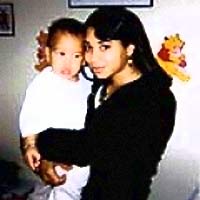
![]() Hearing Voices from NPR®
Hearing Voices from NPR®
058 Motherly Love: Moms, Young and Old
Host: Barrett Golding of Hearing Voices
Airs week of: 2011-05-04 (Originally: 2009-05-06)
“Motherly Love” (52:00 mp3):
For Mother’s Day:
Muriel & Walter Murch compose “A Mother’s Symphony” from womb sounds.
In 1996 Radio Diaries producer Joe Richman gave “Melissa Rodriguez from New Haven: Teen Mom” a microphone and tape recorder. Melissa was 18 and pregnant. Joe asked her to make an audio journal of her life, for the series Teenage Diaries.
Amy Jo, single mother of two toddlers, is “Surrounded by Lights,” by producer Erin Mishkin of Public Radio Redux and SALT Institute for Documentary Studies.
Myra Dean tells StoryCorps of the day her son was killed by a reckless driver.
Ben Adair takes his mom in search of her mom and “Family Baggage.” Ben heads American Public Media‘s Sustainability and Global Climate Change Reporting Initiative.
Katie Davis admits “I Live with My Mother,” part of her DC Neighborhood Stories.
 Toronto musician Charles Spearin with his neighbor “Mrs. Morris,” from The Happiness Project
Toronto musician Charles Spearin with his neighbor “Mrs. Morris,” from The Happiness Project.
Seattle producer Jake Warga‘s “Far Side” calendars make metaphor and memories of his mother’s life and death.
And HV wishes all moms, especially ours, a happy Mother’s Day.

![]() Hearing Voices from NPR®
Hearing Voices from NPR®
057 Roof of the World: In the Himalayas
Host: Scott Carrier of Hearing Voices
Airs week of: 2010-07-07 (Originally: 2009-05-06)
“Roof of the World” (52:00 mp3):
Tibet and Nepal:
Walking a circuit alongside pilgrims, yaks and yogis, host treks one of the world’s most venerated — and least visited — holy sites, Mount Kailash. Produced for Stories from the Heart of the Land. Scott Carrier teaches Journalism at Utah Valley University in Orem.
And we climb to a remote Nepalese town of going up a mountain and back in time. Technical director: Flawn Williams, narrator: Joe Frank.

 It’s an all Scott Carrier This American Life this weekend. Friendly men, schizophrenic tests, amnesia and love, all wrapped up in an adoring Ira hour.
It’s an all Scott Carrier This American Life this weekend. Friendly men, schizophrenic tests, amnesia and love, all wrapped up in an adoring Ira hour.
07/12/05 by Jay Alllison
 At our radio stations (WCAI/WNAN/WZAI for the Cape and Islands in Massachusetts), we have been experimenting with interstitial time since the day we signed on. By interstitial time, I mean the cutaways, the hourly breaks, all the little moments between programming blocks, the cracks in the sidewalk.
At our radio stations (WCAI/WNAN/WZAI for the Cape and Islands in Massachusetts), we have been experimenting with interstitial time since the day we signed on. By interstitial time, I mean the cutaways, the hourly breaks, all the little moments between programming blocks, the cracks in the sidewalk.
We use that time to create our station signature, to declare our sensibility in 30, 60 and 90 second bursts.
Our first experiment is something we dubbed, “Sonic IDs,” an odd name that stuck. These are little community vignettes — portraits, anecdotes, oral histories, overheard conversation, short poems, jokes, slices of life — that end with our call letters. They are sudden narratives or images — like photographs for radio. Some are pure sound preceded by our favorite word: “Listen.” Others are simply the unheralded voices of our neighbors telling something about life. Our test of these surprising, non-standard moments, the way we know they work, is if the listener turns and looks at the radio when the come on. (Current article: “Bursts of lush and local life are new stations’ trademark“.)
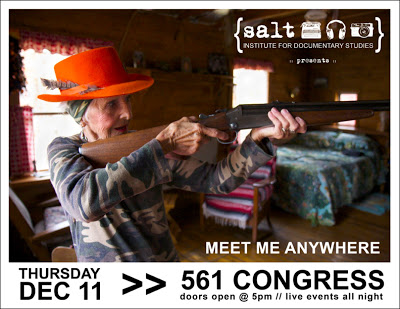 [Rob Rosenthal, host of the SALTcast, and Radio instructor at the SALT Institute for Doc Studies, begins each semester with a talk about…]
[Rob Rosenthal, host of the SALTcast, and Radio instructor at the SALT Institute for Doc Studies, begins each semester with a talk about…]
The Power of Sound
In the womb, our first connection to the outside world is through sound. Heartbeats. Voices.
When we’re born, our first impulse is to make sound.
Some creation myths say, in so many words, in the beginning there was sound.
Our voice starts deep within us and moves out into the world and into another person. Touch at a distance someone once said. And yes, sound enters us — all the time. We can’t help but hear. We don’t have earlids, as producer Jay Allison likes to say.
Our voice is a mixture of the air and our thoughts. They mingle together.
And this is a new thought to me. I’m still working on it. But, humans make sound. Think about it. We don’t make light. We don’t make taste. We don’t make touch, per se. Okay, I suppose you could aruge we make smells but that’s not something we fully control. But sound…we can create sound. We talk. We sing. We’re able to make noise with our bodies and because of our bodies — that’s how we’re constructed. That’s unique among the senses.
Have I gone off the deep end yet? No? Well try this.
Radio taps into something ancient. Something primal. Long before the printed word. Long before pictures and film. Waaay before Facebook, we communicated in sound. It’s all we had. We’ve been passing along information and telling stories sonically for about a bazillion years. At this point, it’s just how we’re wired. Radio plugs right into that.
With radio, the listener is a co-author. Radio engages the mind like a good book and we paint our own pictures. Television, which I know is an easy target, but for comparison, television tells you everything you need to know with its combination of pictures and sound. Radio lets you think.
Radios are inexpensive and ubiquitous — most homes have a good half dozen. You can be illiterate and ‘get’ radio.
There’s something magical about the radio. How the hell does sound get into that little box? If you talk to old school radio engineers, they’ll tell you the “M” in “F. M.” Stands for magic. I’ll let you guess what the “F” stands for. In fact, when radio was first discovered, it was thought that we tapped into a mysterious atmospheric element, the ether. I actually like to believe that’s true. More…

![]() Hearing Voices from NPR®:
Hearing Voices from NPR®:
056 An Hour of Earth— For Earth Day
Host— Barrett Golding of Hearing Voices
Airs week of— 2009-04-15
“An Hour of Earth” (52:00 mp3):
Walk on the wild side with earthly tales of animals, environments, and outdoor adventure:
We canoe Wyoming’s “Green River” (1994) with Scott Carrier.
Tom Lopez of ZBS records some samba “Singing Frogs” in Brazil, or are they toads?
Poet Andrei Codrescu, of The Exquisite Corpse, composes a microcosmic “Environment” based on burgers (from No Tacos for Saddam 1992).
“Subtext: Communicating with Horses” is Jay Allison‘s inter-species conversation, part of his 1985 series Animals and Other Stories.
And Sarah Vowell has subterranean supper in the Carlsbad Caverns’ “Underground Lunchroom”, from a 2001 This American Life.